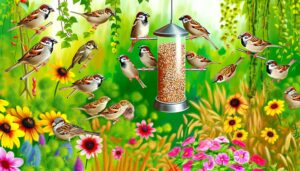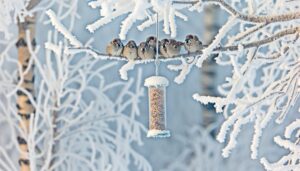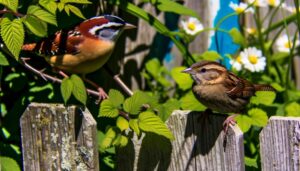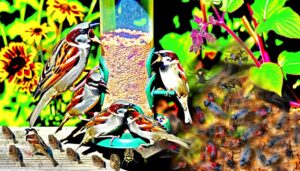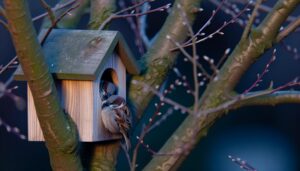House Sparrow Vs Italian Sparrow – 5 Key Differences
The House Sparrow and Italian Sparrow exhibit distinct characteristics. Males of the House Sparrow have gray crowns and black bibs, while Italian Sparrows have chestnut crowns.
Italian Sparrows are slightly larger and possess a robust bill. Geographically, House Sparrows are widespread globally, whereas Italian Sparrows are localized in Italy and the Mediterranean.
Habitat preferences differ, with House Sparrows thriving in urban areas and Italian Sparrows favoring semi-natural landscapes. Dietary habits show that while House Sparrows primarily consume grains, Italian Sparrows have an omnivorous diet.
These differences reflect their unique ecological adaptations and evolutionary histories, with further details to uncover.
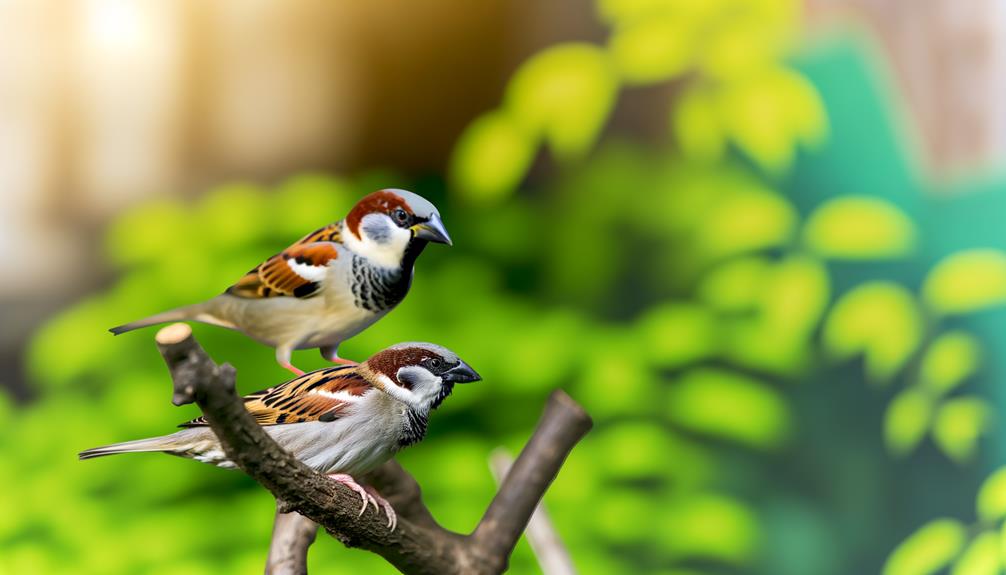
Key Takeaways
- House Sparrow males have gray crowns and black bibs, while Italian Sparrow males have chestnut crowns.
- House Sparrows are widespread globally, whereas Italian Sparrows are mainly found in Italy and the Mediterranean.
- House Sparrows prefer urban environments; Italian Sparrows favor semi-natural landscapes and agricultural areas.
- Italian Sparrows have a broader diet, including insects, while House Sparrows primarily consume seeds and grains.
- House Sparrows have shorter lifespans and are more prone to avian malaria and poxvirus compared to Italian Sparrows.
Physical Appearance
The physical appearance of the House Sparrow (Passer domesticus) and the Italian Sparrow (Passer italiae) exhibits notable differences in plumage coloration, sexual dimorphism, and morphological features.
Passer domesticus males are characterized by their gray crowns, black bibs, and white cheeks, while females display a more subdued brown and gray plumage. In contrast, Passer italiae males have a chestnut crown, black bib, and white cheeks, though the females resemble those of Passer domesticus.
Morphologically, the Italian Sparrow is slightly larger, with a more robust bill adapted for varied diets. Sexual dimorphism is more pronounced in the House Sparrow, with males exhibiting brighter and more distinct markings.
These distinguishing features aid in species identification and understanding their ecological adaptations.
Geographic Distribution
Beyond their physical differences, House Sparrows (Passer domesticus) and Italian Sparrows (Passer italiae) also exhibit distinct geographic distributions, with the former being widespread across Europe, Asia, and the Americas, while the latter is mainly found in Italy and parts of the Mediterranean region.
House Sparrows are renowned for their adaptability, inhabiting diverse environments from urban centers to rural areas globally. Their extensive range is a reflection of their ecological flexibility. In contrast, Italian Sparrows have a more restricted range, mainly localized in the Italian Peninsula and adjacent islands, including Sicily and Corsica.
This limited distribution suggests a narrower ecological niche and potentially different evolutionary pressures compared to their cosmopolitan counterparts. The biogeographic patterns of these species highlight their adaptive divergence.
Habitat Preferences
Contrasting habitat preferences reveal that House Sparrows thrive in both urban and rural settings, whereas Italian Sparrows mainly occupy semi-natural landscapes and agricultural areas.
House Sparrows (Passer domesticus) exhibit remarkable adaptability to human-altered environments, frequently nesting in buildings and foraging in city parks and gardens. Their presence in rural areas is equally pronounced, often seen around farms and open countryside.
Conversely, Italian Sparrows (Passer italiae) exhibit a predilection for less urbanized habitats. They are mainly found in regions with minimal human disturbance, such as orchards, vineyards, and woodland edges.
This habitat specialization is indicative of ecological niche differentiation, influenced by evolutionary adaptations to local environmental conditions. Therefore, habitat preferences distinctly demarcate these two closely related species.
Diet and Feeding Habits
Exhibiting diverse dietary strategies, House Sparrows mostly consume seeds and grains, while Italian Sparrows demonstrate a broader diet that includes a significant proportion of insects and other invertebrates.
House Sparrows primarily forage on the ground, targeting agricultural areas and urban settings with abundant food supplies. Their granivorous tendencies are complemented by occasional consumption of insects during breeding seasons.
Conversely, Italian Sparrows exhibit more omnivorous feeding behaviors. Detailed observations reveal that they forage not only on seeds and grains but also actively hunt arthropods, especially during warmer months. This dietary plasticity allows Italian Sparrows to exploit varied ecological niches.
The comparative analysis of these feeding habits underscores the adaptive differences between the species, contributing to their respective ecological roles and habitat utilization.
Breeding and Nesting
A detailed comparison of breeding and nesting behaviors reveals distinct strategies between House Sparrows and Italian Sparrows, influenced by their respective ecological contexts.
House Sparrows typically breed in urban environments, utilizing cavities in buildings and other man-made structures. In contrast, Italian Sparrows often prefer rural settings, selecting natural crevices or dense vegetation for nesting.
- House Sparrows: Utilize artificial structures, breed year-round in some regions, exhibit high nest site fidelity, and demonstrate frequent brood parasitism.
- Italian Sparrows: Prefer natural sites, have a defined breeding season, show moderate nest site fidelity, and rarely exhibit brood parasitism.
- Clutch Size: House Sparrows generally have larger clutches than Italian Sparrows.
- Nesting Material: Both species use grass and feathers, but Italian Sparrows incorporate more natural elements.
This comparative analysis underscores the adaptability and ecological specificity of their breeding strategies.
Social Behavior
In examining the social behavior of House Sparrows and Italian Sparrows, key differences and similarities emerge in their group dynamics, mating rituals, and feeding hierarchies.
House Sparrows display well-defined social structures with clear dominance hierarchies within flocks, whereas Italian Sparrows exhibit more fluid social interactions.
Mating rituals in both species involve intricate displays, but Italian Sparrows tend to engage in more elaborate courtship behaviors, while House Sparrows prioritize nesting site defense.
Group Dynamics
House Sparrows (Passer domesticus) and Italian Sparrows (Passer italiae) exhibit distinct social structures and group dynamics, influenced by their respective environmental contexts and evolutionary histories. House Sparrows are highly gregarious, forming large flocks that provide mutual protection against predators.
Conversely, Italian Sparrows tend to form smaller, more territorial groups, reflecting their Mediterranean habitat.
- Flock Size: House Sparrows form larger flocks compared to Italian Sparrows.
- Territoriality: Italian Sparrows display stronger territorial behaviors.
- Social Hierarchy: House Sparrows demonstrate more complex social hierarchies within their flocks.
- Foraging Behavior: House Sparrows often forage in groups, whereas Italian Sparrows may forage individually or in smaller groups.
These differences underscore the adaptive strategies each species employs to thrive in their respective environments.
Mating Rituals
While both species exhibit intricate mating rituals, the courtship behaviors of House Sparrows and Italian Sparrows reveal significant differences rooted in their respective ecological niches and evolutionary pressures. House Sparrows (Passer domesticus) engage in vigorous displays, including wing flicking and vocalizations to attract mates. Conversely, Italian Sparrows (Passer italiae) demonstrate more elaborate nest-building activities as a courtship strategy, reflecting their adaptation to varied environments.
| Species | Courtship Behavior | Ecological Adaptation |
|---|---|---|
| House Sparrow | Wing flicking, vocalizations | Dense urban areas |
| Italian Sparrow | Elaborate nest-building | Varied rural and urban environments |
| Comparative Note | Vigorous displays | Reflects differing evolutionary pressures |
These distinctions highlight how each species has evolved unique mating strategies to optimize reproductive success within their habitats.
Feeding Hierarchies
Feeding hierarchies among House Sparrows and Italian Sparrows exhibit notable variations, with each species displaying distinct social structures influenced by their environments. House Sparrows typically form structured dominance hierarchies, with older and more dominant males accessing food resources first.
Conversely, Italian Sparrows demonstrate a more egalitarian feeding structure, possibly influenced by their hybrid origin and varied habitat.
Key observations include:
- House Sparrows: Dominance largely dictated by age and sex, with males generally dominating females.
- Italian Sparrows: Less rigid hierarchy, with frequent sharing of resources among individuals.
- House Sparrows: Hierarchical disputes and aggressive interactions more common.
- Italian Sparrows: More cooperative feeding behavior, reducing conflict at feeding sites.
These differences underline the impact of ecological and evolutionary pressures on social behavior.
Vocalizations
In analyzing the vocalizations of both the House Sparrow (Passer domesticus) and the Italian Sparrow (Passer italiae), notable differences in frequency, pitch, and complexity have been observed, providing insights into their communication strategies and ecological adaptations.
House Sparrows exhibit a broader range of frequencies, utilizing more repetitive and simpler calls, likely adaptive for urban environments with high ambient noise.
In contrast, Italian Sparrows produce more complex and varied songs, suggesting a need for nuanced communication in their diverse habitats. Spectrographic analyses reveal that the Italian Sparrow's calls have a higher frequency range and greater pitch variation, facilitating mate attraction and territory defense.
These vocal distinctions underscore the species' divergent evolutionary paths and adaptive behaviors.
Lifespan and Health
In examining the lifespan and health of the House Sparrow (Passer domesticus) and the Italian Sparrow (Passer italiae), significant differences emerge regarding their average lifespans, susceptibility to common health issues, and disease resistance levels.
The House Sparrow typically exhibits a shorter average lifespan compared to the Italian Sparrow, potentially attributable to varying environmental pressures and genetic factors.
Moreover, while both species face similar health challenges such as parasitic infections and avian diseases, the Italian Sparrow demonstrates a comparatively higher resilience to certain pathogens.
Average Lifespan Comparison
Although both the House Sparrow (Passer domesticus) and the Italian Sparrow (Passer italiae) share similar habitats and ecological niches, their average lifespans exhibit notable differences due to distinct health factors and environmental pressures. Typically, these variations are influenced by:
- Predation rates: House Sparrows often face higher predation risks in urban settings, reducing average lifespan.
- Environmental stressors: Italian Sparrows, more adapted to Mediterranean climates, may suffer less from temperature extremes.
- Disease prevalence: Differing susceptibilities to local pathogens can impact longevity.
- Dietary resources: Variability in food availability influences nutritional health and lifespan.
House Sparrows generally live around 3-5 years in the wild, whereas Italian Sparrows can average slightly longer, up to 4-6 years, highlighting the subtle yet impactful ecological differences.
Common Health Issues
Understanding the common health issues faced by House Sparrows and Italian Sparrows requires examining the specific diseases and physiological stressors that greatly impact their longevity and overall health. Both species are susceptible to avian malaria, which is caused by Plasmodium parasites, leading to significant morbidity.
Additionally, both sparrows often suffer from respiratory ailments due to bacterial infections like Mycoplasma gallisepticum. Nutritional deficiencies, particularly in urban environments, further exacerbate health issues, reducing lifespan.
House Sparrows, often found in densely populated areas, are prone to higher levels of lead and other pollutants, contributing to physiological stress. Conversely, Italian Sparrows, although similarly affected, tend to inhabit less polluted areas, possibly moderating these effects.
Therefore, environmental context plays a critical role in their health outcomes.
Disease Resistance Levels
Evaluating the disease resistance levels of House Sparrows and Italian Sparrows necessitates a comparative analysis of their respective lifespans and health outcomes in relation to pathogen exposure and immune response efficacy.
House Sparrows (Passer domesticus) generally exhibit robust immune responses but are susceptible to avian malaria and poxvirus. Italian Sparrows (Passer italiae), a hybrid species, show intermediate resistance levels, balancing traits from House Sparrows and Spanish Sparrows.
Significant observations include:
- Lifespan: House Sparrows typically live 3-5 years, while Italian Sparrows range from 2-4 years.
- Pathogen Susceptibility: House Sparrows have higher susceptibility to avian malaria.
- Immune Response: Italian Sparrows possess a more generalized immune adaptation.
- Health Outcomes: Both species exhibit similar recovery rates from common infections.
This comparative analysis highlights nuanced differences in disease resistance.
Conservation Status
The conservation status of the House Sparrow (Passer domesticus) and the Italian Sparrow (Passer italiae) reveals significant differences in their population trends and threats.
House Sparrows have experienced notable declines in urban populations across Europe and North America, primarily due to habitat loss, pollution, and predation. Conversely, Italian Sparrows, largely confined to Italy and parts of the Mediterranean, exhibit more stable population trends.
Detailed observations suggest that Italian Sparrows benefit from less urbanization and a greater availability of natural habitats. The International Union for Conservation of Nature (IUCN) lists the House Sparrow as of 'Least Concern,' yet the declines in specific regions warrant focused conservation efforts.
Meanwhile, Italian Sparrows are also classified as 'Least Concern,' with no imminent threats identified.
Conclusion
Coincidentally, the house sparrow and Italian sparrow exhibit distinct yet overlapping characteristics. Both species share similarities in physical appearance and social behaviors, yet diverge in geographic distribution and habitat preferences.
Their diet and feeding habits are remarkably alike, while vocalizations and breeding practices reveal subtle differences. Lifespan and health indicators show commonalities, though conservation status varies considerably.
This comparative analysis underscores the nuanced interplay between ecological factors and evolutionary adaptations in these avian species.

